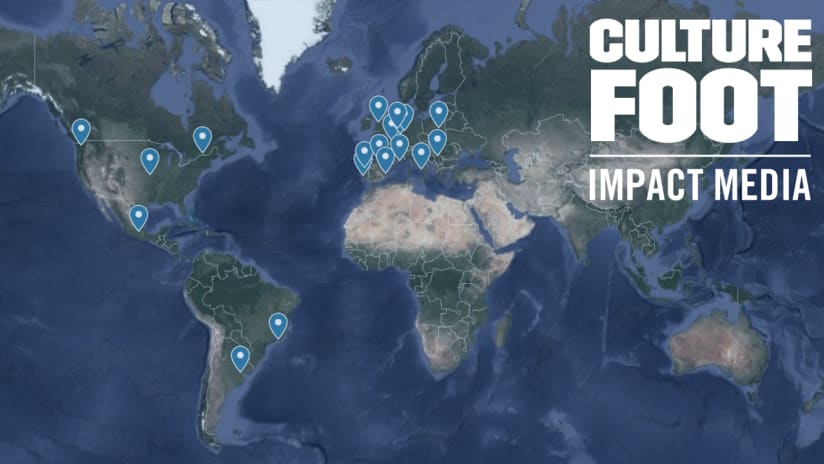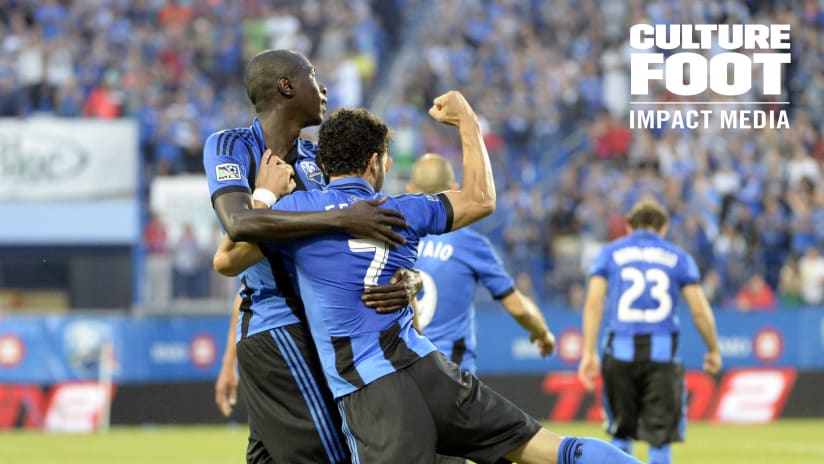Boiling atmospheres
Much is said about what the proverbial 12th player can bring in a football game. Chants, rallying cries, encouragements, but also jeers, whistles, boos, influence the home team positively as much as they influence the visitors negatively. Only a few days before the Bleu-blanc-noir supporters come back to their real home, let’s travel across the world and look at some of the best atmospheres soccer stadiums have to offer. And Impact Media takes this opportunity to remind you of the supporter’s code of conduct at Stade Saputo.
CenturyLink Field
City: Seattle
Club: Seattle Sounders FC
Capacity: 38,300
Open since: 2002
The MLS Sounders’ and the NFL Seahawks’ home has the potential to be amongst the loudest in the world: in 2014, during a game of the other football – the one with the ball in the shape of an egg – in Seattle, supporters beat a Guinness world record by cranking it up to 137.6 dB. In the beautiful game, this debilitating volume has not been reached, but it is always complicated for a team to visit CenturyLink Field, which holds the best average attendance in the league.
Estadio Azteca
City: Mexico City
Club: Club América
Capacity: 87,000
Open since: 1966
The stage of hopeful scenes, if not of rejoicing, for Montrealers in 2015, the Azteca is the first stadium to have welcomed a FIFA World Cup final twice – we will talk about the other venue later in this article. The biggest stadium in Mexico was also the theatre of Diego Maradona’s hand of God, followed four minutes later by the goal of the century by the same Diego against poor England who, still today, seems incapable of getting over it.
Children’s Mercy Park
City: Kansas City
Club: Sporting Kansas City
Capacity: 18,467
Open since: 2011
Nicknamed “The Cauldron”, Children’s Mercy Park is known for being hot. In fact, Kansas City currently holds the world record for the loudest crowd: the NFL’s Chiefs and their large crowd once reached 142.2 dB. This urban spirit is reflected in the Midwest’s football culture, SKC’s supporters having their very own reputation for being loud party animals.
Stade Saputo
City: Montreal
Club: Montreal Impact
Capacity: 20,801
Open since: 2008
The bell. The chants. The electricity. Stade Saputo and Montreal offers a unique atmosphere, well worth the price of the season tickets, in total objectivity.
Estadio Alberto J. Armando (La Bombonera)
City: Buenos Aires
Club: Boca Juniors
Capacity: 49,000
Open since: 1940
It’s a rumble – literally – in Buenos Aires. La Bombonera, the home of Boca Juniors, and its crowd triggered the needle of a seismograph for one of their goals. When they are not busy starting an earthquake, the Xeneizes have fun and party like there’s no tomorrow.
Maracanã
City: Rio de Janeiro
Club: Clube de Regatas do Flamengo, Fluminense FC
Capacity: 78,838
Open since: 1950
The other stadium to have hosted two World Cup finals – even though the first time, there was not a real final per se, but a final round – and, as well, the Summer Olympic Games, which left it in poor condition, the Maracanã holds the record for the biggest crowd for a sporting event in a stadium. For the last game of the 1950 World Cup, no fewer than 199,854 people crammed into the venue to watch Brazil face Uruguay. Nowadays, two clubs and the Brazil national team share the Maracanã, but concerns are looming about its maintenance.
Estadio da Luz
City: Lisbon
Club: S.L. Benfica
Capacity: 64,642
Open since: 2003
Named Europe’s most gorgeous stadium in 2014 by L’Équipe, Estadio da Luz, built just in time for Euro 2004, is effervescent, notably for those Clássicos against Porto. Even though all of Benfica’s games are started with the flight of an eagle, we remember the flight of a Lion named David Beckham in 2004.
Estadio do Dragão
City: Porto
Club: FC Porto
Capacity: 50,434
Open since: 2003
The on-field rivalry between clubs from the two largest cities in Portugal is also replicated in the stands. The Super Dragões answer chant for chant to the Benfiquistas and the atmosphere is as hot in Porto as it in the capital. See for yourself.
Estadio San Mamés
City: Bilbao
Club: Athletic Bilbao
Capacity: 53,289
Open since: 2013
A special atmosphere reigns at San Mamés. Located in the Basque Country, Athletic Bilbao is proud of its identity: only players born or trained in the Basque Country are recruited in the squad. A philosophy bearing its fruits, as Athletic is one of only three founding La Liga clubs to never have been relegated, as well as ranking second for the number of Copas del Rey won. The supporters’ pride is obvious.
Anfield
City: Liverpool
Club: Liverpool FC
Capacity: 54,074
Open since: 1884
The Kop. You’ll Never Walk Alone. Say no more.
Mestalla
City: Valencia
Club: Valencia CF
Capacity: 55,000
Open since: 1923
Valencia’s stadium design is not for supporters who suffer from vertigo: the stands are particularly steep, which gives the impression that three walls surround the pitch. Supporters sitting – rarely – in the stands are amongst the most demanding in the world and ask a lot of their players, but also know how to support them when they need it the most.
Parc des Princes
City: Paris
Club: Paris Saint-Germain
Capacity: 48,583
Open since: 1972
The second stadium in Paris in terms of capacity, the Parc des Princes has a familiar design for the people of Montreal: architect Roger Taillibert is behind its creation, and it strangely looks like the Olympic Stadium’s bowl. And just like our good old Big O, when it is full, it rocks.
Vélodrome
City: Marseilles
Club: Olympique de Marseille
Capacity: 67,394
Open since: 1937
OM’s famous home, with its immense capacity and renovations for Euro 2016, is intimidating. Already, Marseilles’ supporters are known for giving a hard time to visitors. When they go for it for real, like during rivalry games against PSG, it’s fiery.
Stade Maurice-Dufrasne
City: Liège
Club: Standard de Liège
Capacity: 30,023
Open since: 1909
Our own General Ciman’s old home gets hot for big games, notably the Belgian international’s last under Standard colours against rival Anderlecht.
Signal Iduna Park
City: Dortmund
Club: Borussia Dortmund
Capacity: 81,360
Open since: 1974
This might be the best atmosphere on the planet. Westfalendstadion and its famous Südtribüne, the Yellow Wall, which in itself hosts 24,454 spectators standing up, is tough on the away team. As proof, BVB has not lost a home Bundesliga game for… two years. Original tifos, loud chants, flags as far as the eye can see… It’s the soccer supporter’s Mecca.
Stadio San Paolo
City: Naples
Club: S.S.C. Napoli
Capacity: 60,240
Open since: 1959
The Neapolitans don’t only do good pizza, they also do good football and good atmosphere. Before he left for Juventus, striker Gonzalo Higuaín was adored by the local faithful. Now, a little less so.
De Kuip
City: Rotterdam
Club: Feyenoord
Capacity: 51,117
Open since: 1937
A fierce rival to Ajax Amsterdam, as much on the sporting side than on the civic side, Feyenoord Rotterdam has a stadium full of history – and often full, period. De Kuip in fact celebrated its 80th birthday last week.
Stadion Crvena zvezda
City: Belgrade
Club: Red Star Belgrade
Capacity: 55,538
Open since: 1963
Nicknamed Marakana – after the Brazilian stadium of the same name, which we talked about earlier –, the Rajko Mitić Stadium, also called Red Star Stadium, hosted the 1974 European Championship final, during which Czech Antonin Panenka scored the penalty session’s winning goal with a delicate kick of the toes – a technique now named in his honour. The Delije, which we could translate in “good-looking boys” in English, always create a jumpy atmosphere.
Marszałka Józefa Piłsudskiego
City: Warsaw
Club: Legia Warsaw
Capacity: 31,103
Open since: 1930
Marshall Józef Piłsudski Municipal Stadium or Polish Army Stadium is not the biggest, but it’s very intimidating for visitors. As an example, Legia supporters did strongly protest their disqualification from the Champions League qualifying phase in 2017 for having used a suspended player. Impact Media wishes to completely dissociate itself from any image you could find by googling “Legia Warsaw Celtic UEFA”.




